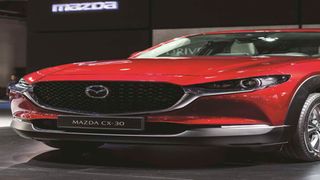
Mazda CX30.
| PoolDN2
Premium
Car of the Year awards countdown continues
Last week we left things off on a bit of a hot note, and this week we continue with the brutality. On to number 4.
No. 4: Mazda CX30
This car could easily have occupied any position, right down to the top of the list, or second to last where it is lurking right now. Many are the upsides. It is very well designed inside and out. Mazda seems to be on a visual charm offensive and they're not relenting until we all cave in and accept that their ascent into premium quality is as real as the SkyActiv technology under the skin of the CX30.
It doesn't just look good, it also handles well and is very heavily specced. When Mazda says they are going after the Germans, they mean it.
Unfortunately, the car is also priced like a German. Costing well north of Sh5 million, the CX30 is very expensive for a vehicle of that size and class. Yes, class, because much as Mazda is repositioning its brand presence into the upper echelons of automotive excellence, it is not quite there yet. It will get there, no doubt about it, but it's not there yet.
It must also be noted that "handling very well" does not necessarily mean "riding very well". At first I thought it was just me, but my usual passenger also raised her eyebrows after the first few bumps and potholes, declared her impatience when we got to Nyahururu to test drive the BJ50 and officially announced that she would like to get back to the British Racing Green 1993 E34 BMW 525i that she now claims as her own, she had had enough of the Mazda. I can't say I disagree with her. The CX30 has a harsh ride that is thumpy over road imperfections and is downright jarring on anything untarmacked. Perhaps we can blame the CX9 that I was driving the week before for skewing expectations upwards, but I can't blame myself for daily-driving a smooth-riding German saloon...
There is something else to blame the CX9 for, and that is the engine. You see, the CX9 comes with a very sweet 2.5 liter turbocharged four cylinder that is a marvel of automotive engineering. I will explain more about this engine when we talk about the CX9 later (spoiler alert: there is a CX9 in this list after all), but the problem is, the CX30 is not available locally with that engine. If you want a CX30 you have to make do with a 2.0 liter naturally aspirated unit. You could stretch to 2.5 liters, still naturally aspirated, but no turbo action for us. Oddly enough, the CX30 can be had with the 2.5 turbo, but in one specific market only – the US.
This highlights other issues that we found with the CX30, jaded as we were by the CX9's awesomeness. The absence of the cooking engine means performance is somewhat underwhelming. I did not call the car slow, because it is not slow, but coming from the sharpness of the CX9 and its stonking turbo powerplant, one would expect a Macan-versus-Cayenne kind of situation where the smaller sibling is more versatile, more responsive and possibly quicker. That is not the situation here. The CX30 feels milder and spongier than its big brother. Very odd.
The lack of the turbo engine also means fuel consumption suffers. I may not have done my scientific measuring method but I do recall the fuel gauge dropping faster than a lot of other hardware we have been handling in the recent past, and this was in highway use. It must be worse in town.
And that, children, is why the CX30 slots in fourth position. It is good enough both to the sight and touch for it to qualify for Car of The Year but it ultimately has to cede ground to its bigger brother because the price is wrong, the ride quality is inconsistent with the brand image and it has been denied what would have been its party-piece – the 2.5 liter turbo four SkyActiv engine.

Proton Saga.
No. 3: Proton Saga
Of all the demonstrators that have passed through our hands, none has spent as much time nor been driven over as large distances and as varied conditions as the 1k-per-day car. There is plenty that is right with this car, the top of the list being it is very affordable. The vehicle is available with 95 per cent financing which means that with a deposit of less than Sh70,000 you can get a brand new car, zero mileage, with a five year-150,000km warranty, on the road. The number plate gang likes this.
Apparently there is such a thing as a National Automotive Policy, the brainchild of our sitting president, which is why you may have noticed a spike in matters to do with local assembly in the recent past. One of the bullet points of this policy was a zero mileage car costing Sh1 million flat, and no, a Mobius II won't cut it. It has to be a "normal" car of the kind Kenyans import used in large numbers, only new.
Enter Simba Corporation and the Proton Saga. Ideally, the base model (Standard Manual) is supposed to cost Sh1.1 million, next up is the Standard Auto for Sh100,000 more, then the Premium Auto for Sh100,000 more than the Standard Auto. It is a small car, underpowered under specific circumstances and with a logo few have heard of, but it costs only a million shillings and comes with a five year-150,000km warranty. What more do you want?
Cat got your tongue? Well, I can tell what more you can have. For that brand new car that you buy for what is the deposit equivalent of one term's school fees for a Grade Two pupil in an average private school, you also get a service kit that is good for 30,000km. With the Premium Auto you also get a high specification vehicle for the money you are paying: Power windows all round (our previous Car of The Year winner, the Polo Vivo only had power windows at the front), electrically adjusted mirrors, reversing camera, parking sensors and a big screen enabled with Android Auto/Apple Car Play. I repeat, this is not a used car you are buying for Sh1 million, this is brand new.
But wait, there is even more. The parking sensors and reversing camera team up with a massive glasshouse and compact dimensions to create what has to be the easiest vehicle to park this side of a lawn mower. It doesn't sound half bad either. The engine may be a 1300 but it has a distant deep thrum at half revs under zero load that would make you swear it was an 1800 (it isn't an 1800). It doesn't look half bad either, in Premium Auto guise. I mean, just look at the car. Look at it. It's not a Pininfarina masterpiece, but neither is it bland nor ugly, is it?
Let's go back to the pricing: Sh67,000 deposit and the aforementioned thousand-shillings-per-day after that. Yes, you read that right: Sh1,000 per day. You can own this car for less money than it costs to hire it. Post-deposit, the monthly instalments amount to Sh29,999, basically Sh30,000 per month, and there are 30 days in a month so stop asking what Sh1,000 per day means.
I took the car to Lodwar for the Great Run 18 recce (video available on our YouTube channel), and it passed muster without qualm. Then it took part in the Great Run itself, again to Lodwar, and it didn't break a sweat either. Ever heard of "The Little Engine That Could"? This is the Little Car That Could.
So why is it not Car of The Year? After all, it ticks all the right boxes. Well, two reasons. First, it is not without flaw and second, the top two cars are far much better. Let's discourse on this.
The Proton Saga is a 1300cc four-cylinder with a hair under 100hp. My BMW 525i is a 2500cc six-cylinder. Twice the capacity, almost twice the number of cylinders and at a hair under 200hp, close to twice the power. It is a longer, wider vehicle made from pig iron so I guess it weighs almost twice as much as the Proton. At 400,000km, it has done not twice but more like 20 times the mileage the Proton will have done in the first quarter of 2022. So why, in the name of internal combustion, am I getting better fuel consumption from that rattletrap BMW compared to the Proton? Strike One.
The Proton, the looker that it is, comes with very tiny wheels, 14 inches if I'm not wrong. With the current status of road expansion and expressway creation, roadworks are aplenty, bumps abound and potholes are ubiquitous. You do not want to drive on imperfect roads with this car, no you don't. You will feel everything under you, and worse, the car has a nose-down stance and a low-hanging sump guard that means anything taller than three inches will scrape the underside of the vehicle creating a noise that sounds more expensive than it actually is.
Then there is build quality. Yes, the car is cheap (not just affordable, it is actually cheap) but the boot could do with some better lining. We have rubber mats being peddled at 500 bob per square meter: these could work really well to erase the acreage of bare metal that is immediately visible once you open the boot, and the rear left door showed signs of poorly fitted rubber linings but we could call these teething problems. The biggest issue is the front door windows are badly in need of rain guards.
The first time I used the windshield washers, the water came right through the driver's window to drip directly onto the control panel of the power windows, which is electrical. Errr... pass. That the water was muddy meant that I was fouling up the door cards in the process. Err... pass. How much is a rain guard?
Then there is the gearbox. The 1300cc spirit is willing but the 4-speed heart is weak and dimwitted. 4-speed automatic, when we are almost a quarter way into the 21st Century. Really? There is a marked hesitation to kick down under wide open throttle, and selecting "S" using the lever causes the vehicle to redline in every single gear. Also, once you get to about 140km/h there is an unwillingness to keep accelerating even without passengers or luggage, and with the windows shut. You won't need to do these speeds though, I attempt them so that you don't have to.
That said, the Saga came close to being our CoTY winner but some last minute entries forced it into third position. What last minute entries are these?

BAIC BJ40/Mobius III
No. 2: BAIC BJ40/Mobius III
Despite the similarity in model nomenclature, the BAIC BJ50 has no relation to the Sagak Tech BJ50 from last week apart from the fact that both feature in this list of nominees... oh, and both are marketed as "Kenyan" vehicles, even though the BAIC BJ40 most definitely is not.
What is the BAIC BJ40? It is what is now known as the Mobius III.
Why is it second on our list? It's a damn good vehicle, that's why.
Let's get the genealogy out of the way first. The most straightforward way to describe the vehicle is: It is a Kenyan version of the Chinese version of an American car. The American Jeep Wrangler was heavily plagiarised to create the Chinese BAIC BJ40 which was then rebadged as the Kenyan Mobius III. Low hanging fruit in the form of troll fodder, this is, but before you start poking fun at it, perhaps you may want to check it out. You will be surprised.
As I was.
I won't explain how I wound up behind the wheel of a Mobius since I have been declared enemy of the state at that enterprise, but I must say I do not regret, for a moment, the subterfuge I dabbled in to ensure this test drive happens. The Mobius III, for lack of a better descriptor, is wonderful.
It is a Jeep Wrangler knock-off, but that is not a bad thing, is it? I cannot criticise it since I recommended that exact same directive in an insightful piece I did for the East African five years ago. That solves the exterior – it looks cool. Very cool.
The interior is even cooler, if you can believe it, and you should. The fit and finish is exemplary, and not just that. The detailing is at a very high level. The vents, the start button and the whole centre console looks like it was lifted from, wait for it, a Mercedes Gelandewagen, the G Class. And not just any G Class, the 2021 G Class. This car rocks.
The roof panels are detachable so you can replay your own Rick Ross "I Think I'm Big Meech" experience should you so desire. It has big wheels. You can see the suspension from the sidewalk. It is powered by a turbocharged Saab engine. You can have it manual or auto. I drool harder and harder the further down I go the specifications list. And the cost? Well, let me just put it this way: Why would you buy a 1.8 liter naturally aspirated Toyota Corolla Cross when for the same money you can have a 2.0 liter turbocharged Jeep Wrangler knockoff with a G Class imitation interior? Let's drive this car, shall we?
The steering wheel is chunky and thick-rimmed, which is a good start. The windshield and dashboard rakes are close to 90 degrees, so yes, you do feel like you are in a heavily muffled G Class, only less tall. Then you open the taps and discover why the Subaru boys are so deeply in love with turbocharging...
This car goes, it really does. Two litres may not sound like much, and it really isn't but past experience with the Volkswagen Amarok has proven that boost life is the best life and you can make Brock Lesnar win a heavyweight match with the ticker of a 9-year old geek. This Mobius is Brock Lesnar. The Amarok is The Rock (naturally). Welcome to WWE: the World of Welterweight Engines.
So why is the Mobius III second? First, it is in recognition of how far they have come. Starting with a barely presentable World War II-era motorised kiosk, through sketchy marketing, and now to this – credit where it is due. Tesla started off as an electrified Lotus Elise, Mobius is in its third iteration as a glammed up Jeep Wrangler with Saab power running Chinese interference, and the result is epic, to be honest. At four and a half million bob, I want one. Or two, or three, or four, for my friends and I to go adventuring in.
Secondly is on its own merit. Rarely do you find a full-on SUV running a compact engine from the inventors of turbocharging, makers of fighter aircraft and parents Scania trucks and buses, all while boasting an interior borrowing design cues from AMG and/or Pagani (yes, the vents look like they were lifted off of a Huayra BC) complete with a bespoke infotainment system that reminds you that you may think you are on a Jeep or a G Class, but you are in fact, inside a Mobius.
I cannot promise a full review because we are still enemies with the folks at Mobius. But like I said last week, this goes above and beyond petty squabbles about who said what about who, the Mobius III is the closest we have come to having a 2021 Car of The Year. We will announce the winner come 2022.
[Clever readers may have surmised that the 2021 Car of The Year is the Mazda CX9. To find out how or why it won, see you in 2022.]





